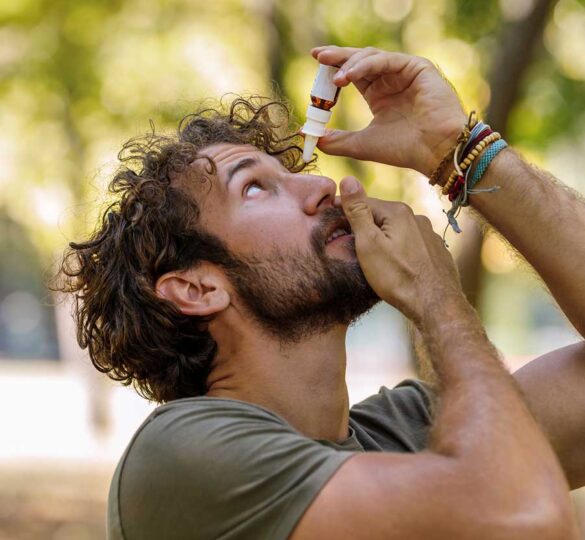How to Lower Intraocular Eye Pressure
Reducing IOP lowers the risk of further glaucoma damage, helping to slow or even halt the progression of the disease.

Lowering intraocular pressure (IOP) — the fluid pressure inside your eye — is crucial for glaucoma patients because elevated IOP is a major risk factor for optic nerve damage, which can lead to irreversible vision loss. For people with glaucoma, the increased pressure within the eye strains the optic nerve, progressively impairing its function.
Reducing IOP lowers the risk of further glaucoma damage, helping to slow or even halt the progression of the disease. Early intervention to lower IOP, whether through medication, laser treatments, or surgery, can help preserve the patient’s remaining vision and maintain their quality of life.
Continue reading to explore practical ways to lower your IOP and keep your eyes healthy.
Use Prescription Eye Drops
Laser treatment and prescription eye drops are the most commonly used and effective ways to lower IOP, by helping to reduce fluid production or increase fluid drainage in the eye. Depending on your condition, your doctor might prescribe eye drops in the form of beta-blockers, carbonic anhydrase inhibitors, prostaglandin analogs, alpha agonists, or Rho kinase inhibitors. Following your doctor’s instructions carefully is essential, as inconsistent use will reduce their effectiveness.
Tip: Regular follow-up appointments with your eye doctor are important to monitor the effectiveness of treatment and the stability of the glaucoma disease process. Your doctor can adjust your treatment plan as necessary.
Maintain a Healthy Diet
Your diet can have an impact on your eye health. A balanced diet of antioxidants, vitamins, and minerals can support eye function. Foods that are particularly beneficial for eye health include:
- Leafy greens like spinach and kale (rich in lutein and zeaxanthin)
- Citrus fruits for vitamin C
- Fish high in omega-3 fatty acids (such as salmon)
- Nuts for vitamin E
- Meat, fish, milk, and eggs which have high levels of nicotinamide, a form of vitamin B3
Tip: Avoid excessive caffeine consumption, as it may cause short-term spikes in IOP.
Exercise Regularly
Moderate exercise — walking, swimming, or cycling — has been shown to lower intraocular pressure. Engaging in cardiovascular activities helps improve blood flow and can contribute to healthier eye pressure. Moreover, regular physical exercise is strongly associated with improved cardiovascular and brain health, including a reduced risk of dementia. However, specific high-impact or inverted exercises (like weightlifting or yoga inversions) might temporarily increase IOP, so choose your workouts wisely.
Stay Hydrated — But in Moderation
Drinking water is essential for overall health, including your eyes. However, consuming large quantities of water in a short amount of time can cause your IOP to rise. Drinking moderate amounts of water regularly throughout the day is the best way to stay hydrated.
Tip: Aim for eight cups of water per day, spaced out, to support eye health and general well-being.
Practice Eye-Friendly Habits
Adopting eye-friendly habits can also help manage intraocular pressure:
- Take regular breaks from screens to reduce eye strain (try the 20-20-20 rule: every 20 minutes, look at something 20 feet away for 20 seconds).
- Avoid smoking, as it increases the risk of eye diseases, including glaucoma.
- Sleep with your head slightly elevated (consider using a wedge pillow), which has been shown to slightly lower the IOP compared to laying flat.
Tip: Regular eye checkups are crucial, especially if you have risk factors for glaucoma. Early detection is vital to prevent vision loss.
Consider Surgery When Necessary
Research shows that SLT is the preferred treatment for patients with ocular hypertension (OHT) and primary open-angle glaucoma (POAG). Surgery for glaucoma can help lower pressure when medication is not sufficient. In some cases, surgeries such as trabeculectomy or aqueous shunts can be more effective at lowering eye pressure and preventing progression of glaucoma. Discuss treatment options with your eye doctor to understand the benefits and risks.
Help Us Provide Hope
Maintaining healthy intraocular pressure is vital to protecting your vision. You can effectively manage your IOP with laser therapy or by using prescription eye drops, exercising regularly, and following your eye doctor’s orders. Regular checkups with your eye doctor are essential to monitor your condition and adjust treatments as necessary.
If you experience any unusual symptoms, such as sudden vision loss or severe eye pain, seek medical attention immediately, as these could be signs of a severe condition.
Take control of your eye health today to keep your vision clear for years!
The tireless work of researchers continues to lead to a better understanding of glaucoma every day. As a result, there’s great hope for new and improved treatments, including innovative drug delivery methods, laser treatments, and less invasive surgical techniques. You can help make that happen!
Your support can help dedicated researchers continue to discover new treatments and cures for glaucoma. Your donations also give hope to those living with glaucoma and accelerate our search for a cure.
Posted November 11, 2024. This article was reviewed for medical accuracy by Angelo P. Tanna, MD.

Angelo P. Tanna, MD
Angelo P. Tanna, MD is Vice Chairman and Professor of Ophthalmology, and Director of the Glaucoma Service at the Northwestern University Feinberg School of Medicine in Chicago, IL.